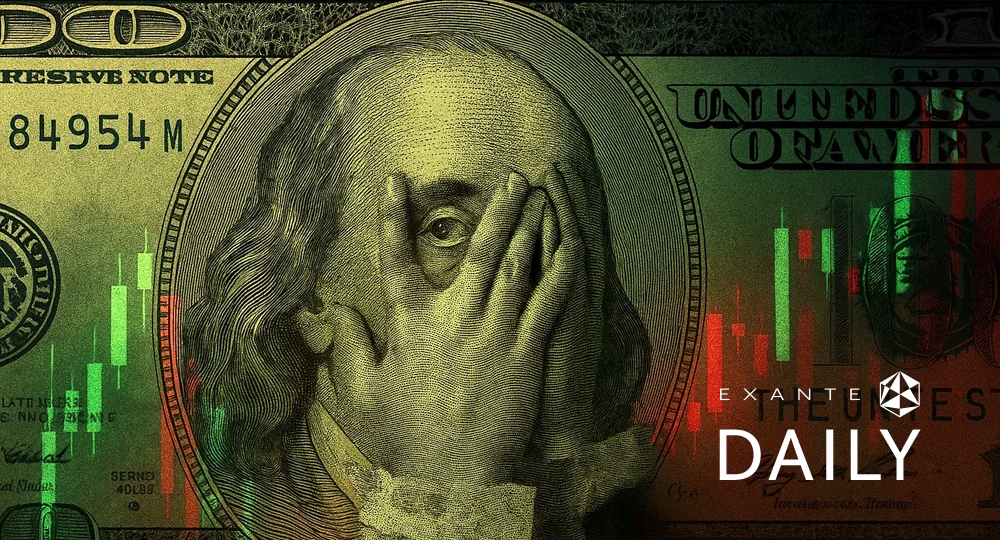
Equities to the moon?

Corporate Earnings News
Global market indices
Currencies
Cryptocurrencies
Fixed Income
Commodity sector news
Key data to move markets this week
Global macro updates
Corporate Earnings News
Corporate earning calendar 16 May - 22 May 2024
Thursday: Walmart, Applied Materials, Deere & Company
Friday: Land Securities
Monday: Palo Alto Networks, Keysight Technologies, Nordson
Tuesday: Lowe’s, Smiths Group
Wednesday: Nvidia, TJX, Analog Devices, Target
Thursday: Intuit, Medtronic, Autodesk, Dollar Tree, Ralph Lauren
US Stock Indices Price Performance
Nasdaq 100 +6.62% MTD +10.52% YTD
Dow Jones Industrial Average +5.53% MTD +5.89% YTD
NYSE +4.40% MTD +9.05% YTD
S&P 500 +5.41% MTD +11.29% YTD
The S&P 500 +2.32% over the past week, with 10 of the 11 sectors having exhibited positive performance MTD. The Equally Weighted version of the S&P 500 posted a weekly +2.15%, its performance is +4.18% MTD +6.34% YTD.
The S&P 500 Information Technology is the leading sector this month, up +8.76% MTD +15.66% YTD, while the Energy sector has exhibited the weakest performance at 0.00% MTD +11.70% YTD.
Major US stock indexes reached record highs after the latest inflation report indicated a moderation in price pressures, defying expectations of hotter readings. The S&P 500, Dow Jones Industrial Average, and Nasdaq 100 all closed at all-time highs on the same day for the first time since 21st March. This marks the S&P 500's 23rd record in 2024, while Wall Street's volatility index (VIX) dropped to its lowest level since January. The Dow Jones Industrial Average rose +0.88%, adding approximately 350 points and nearing the 40,000 mark. The tech-focused Nasdaq 100 increased by +1.49%.

During Wednesday's trading session, gains in the S&P 500 were led by the technology sector, with Super Micro Computer shares rallying +15.81% and Advanced Micro Devices gaining +4.25%. The core Consumer Price Index (CPI), excluding food and energy costs, increased 0.3% from March, ending a streak of three above-forecast readings that had raised concerns about entrenched inflation. The y/o/y measure also cooled to its slowest pace in three years at 3.4%.
While the April report may not prompt the Fed to immediately lower interest rates, it has eased investor fears of persistently high inflation forcing prolonged elevated rates or further increases. This data could shift the narrative back to "when" the Fed will cut rates in 2024, rather than "if" they will cut. Such a shift would likely support risk assets, though a continuation of similar data readings will be needed to solidify this trend.
Meanwhile, a recent surge in meme stocks, reminiscent of the 2021 retail-trading frenzy, lost momentum on Wednesday. GameStop and AMC Entertainment shares crashed -18.87% and -20.00%, respectively, despite remaining up over 125% and 88% for the week.
In corporate news, Walt Disney CEO Bob Iger announced plans to reduce marketing expenses at the flagship Disney+ streaming service to achieve profitability by the end of the fiscal year. Netflix also revealed its intention to air two NFL games on Christmas Day, furthering its push into live events.
US stocks
Mega caps: A mixed week for the ‘Magnificent Seven’ due to a strong earnings season, coupled with momentum in the Information Technology sector driven expectations of potential lower interest rates later this year. Alphabet +1.59%, Apple +3.82%, Meta Platforms +1.89%, Microsoft +3.05%, and Nvidia +4.67%, while Amazon -1.07% and Tesla -0.42% were the only members who lost ground.
Energy stocks had a mixed week this week as the energy sector itself was +0.59%, raising the sector’s YTD performance to +11.70%. Baker Hughes +3.23%, ExxonMobil +2.09%, Halliburton +0.86%, Chevron +0.31%, and Apa Corp (US) +0.10%, while Marathon Petroleum -4.58%, ConocoPhillips -1.92%, Shell -0.78%, Phillips 66 -0.50%, and Occidental Petroleum -0.47%.
Materials and Mining stocks had a positive week, as the materials sector was +1.37%, elevating the sector’s YTD performance to +7.32%. Sibanye Stillwater +9.38%, Freeport-McMoRan +7.31%, Newmont Mining +3.97%, Nucor +3.78%, Mosaic +2.16%, and CF Industries +2.14%, while Albemarle -2.22% and Yara International -0.69%.
European Stock Indices Price Performance
Stoxx 600 +3.93% MTD +9.55% YTD
DAX +5.23% MTD +12.64% YTD
CAC 40 +3.19% MTD +9.24% YTD
IBEX 35 +4.68% MTD +12.48% YTD
FTSE MIB +4.80% MTD +16.52% YTD
FTSE 100 +3.70% MTD +9.21% YTD
European stock markets reached record highs on Wednesday, mirroring the upward trend in the US. The pan-European Stoxx Europe 600 index gained +0.59%, closing at an unprecedented 524.78.
Germany's DAX index also experienced significant growth, rising +0.82% and closing at a record 18,869.36, propelled by stronger-than-anticipated industrial output figures in the Eurozone. France's CAC 40 index saw a more moderate increase of +0.17%, closing at 8,239.99.
The UK's FTSE 100 index likewise achieved a record high of 8,445.80, reflecting a +0.21% gain for the day. This followed a notable surge of approximately 0.40% earlier in the trading session, further underscoring the positive sentiment across European markets.
Other Global Stock Indices Price Performance
MSCI World Index +5.05% MTD +9.56% YTD
Hang Seng +9.08% MTD +13.66% YTD
This week, the Hang Seng Index increased by +4.15%, while the MSCI World Index rose by +2.16%.
Currencies
EUR +2.05% MTD -1.38% YTD to $1.0884
GBP +1.58% MTD -0.31% YTD to $1.2687
The euro was +1.29% against the USD over the past week, while the British Pound was +1.52%.
Sterling reached its highest level against the weakening US dollar in nearly two weeks and remained stable against the euro on Wednesday, ahead of the release of US CPI data.
Market expectations for future BoE rate cuts were largely unchanged, with traders estimating an approximately 50% probability of a first cut in June. A 25 basis point (bps) rate cut in August is fully priced in, and over 50 bps of cuts are expected by year-end.
The Dollar Index this week is -1.14%, and -1.90% MTD, however and maintains a YTD gain of +2.84%. At closing, it’s at a one-month low. On Wednesday, it experienced its most significant single-day percentage drop of the year thus far, falling -0.75% and breaching its 200-day moving average.
Cryptocurrencies
Bitcoin +10.09% MTD +57.20% YTD to $65,913.59.
Ethereum +1.63% MTD +31.74% YTD to $3,010.60.
Bitcoin and Ethereum have been in positive territory over the past week, gaining +8.30% and +2.30%, respectively.
MicroStrategy, renowned for its substantial Bitcoin holdings, will be included in the MSCI World Index following a significant rally in its share price, surpassing the gains of the digital asset itself.
The company was announced as one of the three largest additions to the index based on market capitalisation, according to MSCI's statement on Tuesday. Index providers routinely reassess their gauges, and the latest changes are set to take effect at the end of the month.
This inclusion underscores the growing integration of crypto exposure into traditional investment portfolios, given the substantial assets tracking or benchmarked against the MSCI World Index. Other avenues for such exposure include newly launched exchange-traded funds in the US and Hong Kong that directly hold digital assets, potentially attracting interest from multi-asset funds over time.
MicroStrategy's shares have surged by over 400% in the past year, outperforming Bitcoin's nearly 130% increase amid the crypto market's recovery from the 2022 downturn. While the company is often seen as a proxy for Bitcoin exposure, this role has been questioned following the January debut of US Spot Bitcoin ETFs. The stock further rose by approximately 6% to $1,377 on Wednesday.
In March, Kerrisdale Capital Management announced a short position on MicroStrategy's stock, citing its outperformance relative to Bitcoin's price surge.

Note: As of 6:30 pm EDT 15 May 2024
Fixed Income
US 10-year yield -35.8 basis points MTD +45.8 basis points YTD to 4.32%
German 10-year yield -17.2 basis points MTD +39.5 basis points YTD to 2.42%.
UK 10-year yield -34.0 basis points MTD +52.6 basis points YTD to 4.07%.
US Treasury 10-year bond yields decreased by -17 basis points (bps) this week, reaching a six-week low of 4.32%.
The benchmark German 10-year yield declined by -4 bps, while the UK 10-year yield decreased by -7 bps to 4.07%, the lowest level since 10th April. The spread between US 10-year Treasuries and German Bunds currently stands at 193 bps, down from around 220 bps in mid-April and a -10 bps decrease from 203 bps last week.
Italian bond yields, a benchmark for the eurozone periphery, experienced a marginal increase of +1 basis point to 3.81%. However, the spread between Italian and German 10-year yields narrowed by -1 basis point to 132 basis points, compared to 133 basis points the previous week.
Fed funds futures imply 52 bps of rate cuts from the Fed this year, significantly lower than the 160 bps anticipated at the beginning of the year, and up from 45 bps. For the ECB, traders are pricing in around 70 bps of rate cuts, equivalent to just under three quarter-point moves.
Commodities
Gold spot +0.97% MTD +12.18% YTD to $2,309.04 per ounce.
Silver spot +3.68% MTD +14.71% YTD to $27.36 per ounce.
West Texas Intermediate crude -3.59% MTD +10.24% YTD to $79.21 a barrel.
Brent crude +0.16% MTD +8.48% YTD to $83.58 a barrel.
Gold prices surged during Wednesday's trading session, buoyed by the weakening dollar and bond yields following the release of US CPI data. The data reinforced market expectations of potential interest rate cuts by the Fed as early as September, enhancing gold's appeal as an inflation hedge.
Spot gold prices have climbed +3.35% this week, reaching $2,309.04 per ounce, the highest level in over three weeks. While gold is traditionally considered a hedge against inflation, higher interest rates typically increase the opportunity cost of holding non-yielding assets like gold, making this recent surge particularly noteworthy.
IEA trims oil demand outlook, widening gap with OPEC's projection. The International Energy Agency (IEA) revised its 2024 oil demand growth forecast downward on Wednesday, further diverging from the projection of the Organization of the Petroleum Exporting Countries (OPEC) for the year's global demand.
This discrepancy between the IEA and OPEC presents contrasting views on the oil market's strength in 2024, and over the longer term, on the pace of the global transition to cleaner energy sources.
The IEA, in its monthly report, reduced its forecast for global oil demand growth this year to 1.1 million barrels per day (bpd), a decrease of 140,000 bpd from its previous estimate, primarily due to weaker demand in developed OECD nations. The agency attributed the downward revision to factors such as sluggish industrial activity and a mild winter, which have dampened gas oil consumption, particularly in Europe, where the declining share of diesel cars has already impacted demand.
Conversely, OPEC maintained its forecast of a 2.25 million bpd increase in global oil demand for 2024, resulting in a notable 1.15 million bpd difference, approximately 1% of world demand, between the two organisations' projections.
However, the IEA and OPEC's forecasts for 2025 converge more closely. The IEA slightly raised its demand growth estimate for 2025 to 1.2 million bpd, while OPEC retained its 1.85 million bpd forecast.
The IEA also adjusted its 2024 oil supply estimates downward, citing significant outages in Brazil and logistical constraints in the United States. It now projects a global supply increase of 580,000 bpd this year, reaching a record 102.7 million bpd, down from the 770,000 bpd growth anticipated last month.
This revised supply-demand balance will be a crucial factor in OPEC+'s decision on whether to extend voluntary oil output cuts into the second half of the year when it convenes in June. The IEA now anticipates demand for OPEC+ crude and inventories to average 41.9 million bpd in 2024, a slight increase from 41.8 million bpd estimated last month, suggesting a tighter overall market balance.
While OPEC expressed optimism about the global economic outlook, the IEA adopted a more cautious stance, noting that although the global economic outlook has improved since late 2023, persistent inflation in major Western economies has led investors to temper their expectations for central bank interest rate reductions.
Even if OPEC+ maintains its voluntary production cuts, global oil supply could still surge by 1.8 million bpd in 2025, driven primarily by non-OPEC+ output growth, compared with this year's 580,000 bpd increase.
Furthermore, the IEA and OPEC diverge in their medium- to long-term demand outlook. The IEA predicts a peak in oil demand by 2030, while OPEC anticipates continued growth in oil consumption for the next two decades without forecasting a peak.
Note: As of 6 pm EDT 15 May 2024
Key data to move markets this week
EUROPE
Thursday: Italian Consumer Price Index, and a speech by German Buba President Nagel.
Friday: Eurozone Harmonized Index of Consumer Prices, and a speech by ECB Vice President Luis de Guindos.
Monday: German Buba Monthly Report.
Tuesday: German Producer Price Index, Eurogroup Meeting.
Thursday: German HCOB Composite, Manufacturing and Services PMIs, Eurozone HCOB Composite, Manufacturing and Services PMIs, Eurozone’s Negotiated Wage Rates, and Consumer Confidence.
UK
Thursday: A speech by BoE MPC member Megan Greene.
Friday: A speech by BoE MPC member Catherine Mann.
Monday: A speech by BoE Deputy Governor Ben Broadbent.
Tuesday: A speech by BoE Governor Andrew Bailey.
Wednesday: BoE Monetary Policy Report Hearings, Consumer Price Index, Producer Price Index, Retail Price Index, and a speech by BoE Deputy Governor Sarah Breeden.
Thursday: S&P Global/CIPS Composite, Manufacturing and Services PMIs, and GfK Consumer Confidence.
US
Thursday: Initial and Continuing Jobless Claims, Building Permits, Housing Starts, Philadelphia Fed Manufacturing Survey, Industrial Production and speeches by Cleveland Fed President Loretta Mester and Atlanta Fed President Raphael Bostic.
Friday: Speeches by Minneapolis Fed President Neel Kashkari, Fed Board Member Christopher Waller, and San Francisco Fed President Mary Daly.
Monday: Speeches by Atlanta Fed President Raphael Bostic, and Fed Chair for supervision Michael Barr.
Tuesday: Redbook Index, and speeches by Fed President Raphael Bostic, Cleveland Fed President Loretta Mester, New York Fed President John Williams, and Boston Fed President Susan Collins.
Wednesday: FOMC Minutes, and Existing Home Sales.
Thursday: Initial and Continuing Jobless Claims, New Home Sales, S&P Global Composite, Manufacturing and Services PMIs.
CHINA
Friday: Industrial Production, and Retail Sales.
Monday: PBoC Interest Rate Decision.
JAPAN
Tuesday: Imports, Exports, and Merchandise Trade Balance.
Thursday: National Consumer Price Index.
Global Macro Updates
Signs of cooling US economy: easing inflation, and flat retail sales. US consumer prices increased less than anticipated in April, suggesting that inflation resumed its downward trajectory at the beginning of the second quarter of 2024, bolstering market expectations for an interest rate cut in September.
Hopes that the Fed would initiate its easing cycle this year were further reinforced by additional data released on Wednesday, revealing unexpectedly flat retail sales in April. This suggests a cooling of domestic demand, a development welcomed by Fed officials as they strive to achieve a soft landing for the economy.
The Consumer Price Index (CPI) rose 0.3% in April, following a 0.4% increase in both March and February, according to the Labor Department's Bureau of Labor Statistics. While the higher cost of living has somewhat offset the economy's resilience, the overall inflation rate is showing signs of moderation.
Shelter costs, including rents, increased by 0.4% for the third consecutive month, and gasoline prices surged 2.8%, with these two categories accounting for over 70% of the rise in the CPI. However, food prices remained unchanged, and supermarket prices even declined by 0.2%.
Inflation had accelerated in the first quarter due to robust domestic demand, following a period of moderation for much of the previous year. April's slowdown offered relief after Tuesday's data indicated a jump in producer prices. The current inflationary pressures are attributed to service providers, such as motor vehicle insurance, housing, and healthcare, adjusting their prices to reflect higher costs.
Financial markets now estimate a roughly 73% probability of a rate cut in September, upfrom 69% prior to the data release. Excluding volatile food and energy components, the core CPI rose 0.3% in April, following three consecutive months of 0.4% increases. This has reduced the three-month annualised increase in core CPI to 4.1% from 4.5%.
Based on the CPI and PPI data, economists estimate that the core personal consumption expenditures price index increased 0.2% in April, compared to 0.3% in March. This would result in a decrease in the annual core inflation rate to 2.7% from 2.8% in March.
A separate report from the Commerce Department's Census Bureau revealed that retail sales were unchanged in April after a 0.6% increase in March. Economists had forecast a 0.4% increase in retail sales, which primarily consist of goods and are not adjusted for inflation. However, sales still rose 3.0% year-on-year in April.
While demand appears to be slowing, April's flat reading was partly due to a rebound effect following Amazon's spring promotion, which boosted sales in March. Sales at online retailers decreased 1.2% after surging 2.5% in March. Conversely, sales at food services and drinking places, the only services component in the report, increased 0.2%. Economists view dining out as a significant indicator of household finances.
Excluding automobiles, gasoline, building materials, and food services, retail sales fell 0.3% in April, following a downwardly revised 1.0% increase in March, initially reported as a 1.1% increase. Core retail sales closely align with the consumer spending component of GDP.
Despite the softness in April, the upward revision of March's core retail sales data establishes a higher growth base for second-quarter consumer spending.
Japan's economy contracts more than expected, challenging BoJ's policy path. Japan's economic contraction in the first quarter exceeded expectations, driven by the persistent weakness of the yen. This development poses a new challenge for the central bank's ongoing efforts to normalise interest rates from their near-zero levels.
Preliminary GDP data released on Thursday by the Cabinet Office revealed an annualised contraction of 2.0% in January-March, surpassing the 1.5% decline predicted by economists. Downwardly revised figures also indicated minimal growth in the fourth quarter of 2023, primarily due to adjustments in capital expenditure estimates.
While preliminary capital spending data is often subject to significant revisions, the widespread declines across all GDP components suggest a lack of major growth drivers for the Japanese economy in the first quarter. This may prompt the BoJ to reconsider its policy tightening trajectory, despite having raised interest rates for the first time since 2007 in March and signalling further intentions to continue this path.
Although the economy could potentially rebound in the current quarter due to rising wages, uncertainties persist around service sector consumption. The latest GDP data translates to a quarterly contraction of 0.5%, exceeding the 0.4% decline predicted by economists. Revised first quarter figures are expected on June 10th.
The yen's weakness has created a dual-faceted economic landscape in Japan, benefiting the export and tourism sectors due to increased competitiveness, while simultaneously burdening households and small businesses with elevated import costs.
This situation complicates the BoJ's decision-making regarding the maintenance or unwinding of its monetary stimulus. While substantial wage hikes by large businesses this year have created conditions for ending decades of radical monetary stimulus, according to the BoJ, cautious households have tightened their spending due to price increases outpacing wage gains, thereby squeezing real incomes and diminishing purchasing power.
Private consumption, a major component of the Japanese economy, declined by 0.7% in the first quarter, exceeding the forecasted 0.2% drop and marking the fourth consecutive quarter of decline, the longest such streak since 2009. Capital spending, another key driver of private demand, also decreased by 0.8% in the first quarter, despite strong corporate earnings.
External demand, calculated as exports minus imports, further contributed to the GDP contraction, reducing first-quarter estimates by 0.3 percentage points.
Policymakers are currently relying on significant pay raises and planned income tax cuts to stimulate consumption and prevent a return to deflation. While rate hikes or reductions in bond purchases could alleviate the yen's weakness and potentially boost consumption, such measures may be difficult to implement if consumption remains sluggish.

本文提供給您僅供資訊參考之用,不應被視為認購或銷售此處提及任何投資或相關服務的優惠招攬或遊說。金融商品交易涉及重大損失風險,可能不適合所有投資者。過往績效不代表未來表現。




